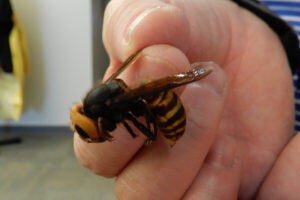As the death toll from the coronavirus continues to climb and millions find themselves struggling to pay bills amid growing economic uncertainty, a new danger may be buzzing on the horizon.
Namely, murder hornets.
The New York Times reported Saturday that the insects, actually called Asian giant hornets, could establish themselves in the United States after two were spotted late last year in Washington state. The creatures got the nickname “murder hornets” ― which the Times says was coined by researchers ― because they’re, well, kinda murder-y.
“They’re like something out of a monster cartoon with this huge yellow-orange face,” Susan Cobey, a bee breeder with Washington State University’s Department of Entomology, said in an April news release from the university.

The hornets are the world’s largest and can grow to more than 2 inches long. Though they aren’t usually aggressive to humans unless their nests are disturbed, their stings are venomous enough to kill someone who gets stung multiple times. According to the Times, the hornets kill up to 50 people a year in Japan and folks on the receiving end of the sting have compared it to the feeling of being speared by hot metal.
They’re also devastating to honey bee populations, wiping out hives and partially consuming the occupants. Last November, a beekeeper in Blaine, Washington, was shocked to discover thousands of his bees with their heads ripped off ― the murder hornet’s signature move.
It was never confirmed that hornets were the killers. But the next month, the Washington Department of Agriculture recovered a dead giant hornet from a property near Blaine, The Bellingham Herald reported at the time. The property owner had also spotted a live giant hornet flying around. The nearby town of Custer also had two reports of the big hornets, which WSU noted were unconfirmed but “probable.”

A few months before the Washington sightings, officials over the border in British Columbia had found and destroyed an Asian giant hornets’ nest.
The hornets’ native range is is eastern and southeast Asia, and it’s not clear how they may have gotten to North America. Scientist fear the hornets could be a major menace to the northwest’s bee populations, causing enormous problems for agriculture and local ecosystems.
Last month, Washington state officials set up dozens of traps meant to capture any giant hornet queens that would be coming out of a long winter of dormancy underground, and said they’d be encouraging people to make homemade bottle traps.
But while officials are enlisting the public’s help in locating the hornets, they’re also encouraging people to be cautious. State entomologist Chris Looney told The Bellingham Herald that anyone who comes across the hornets should remain calm, but nevertheless keep their distance.
“If you encounter these, run away,” he said.
